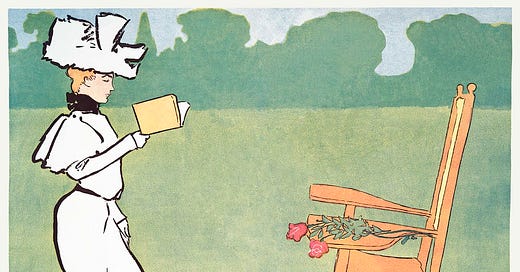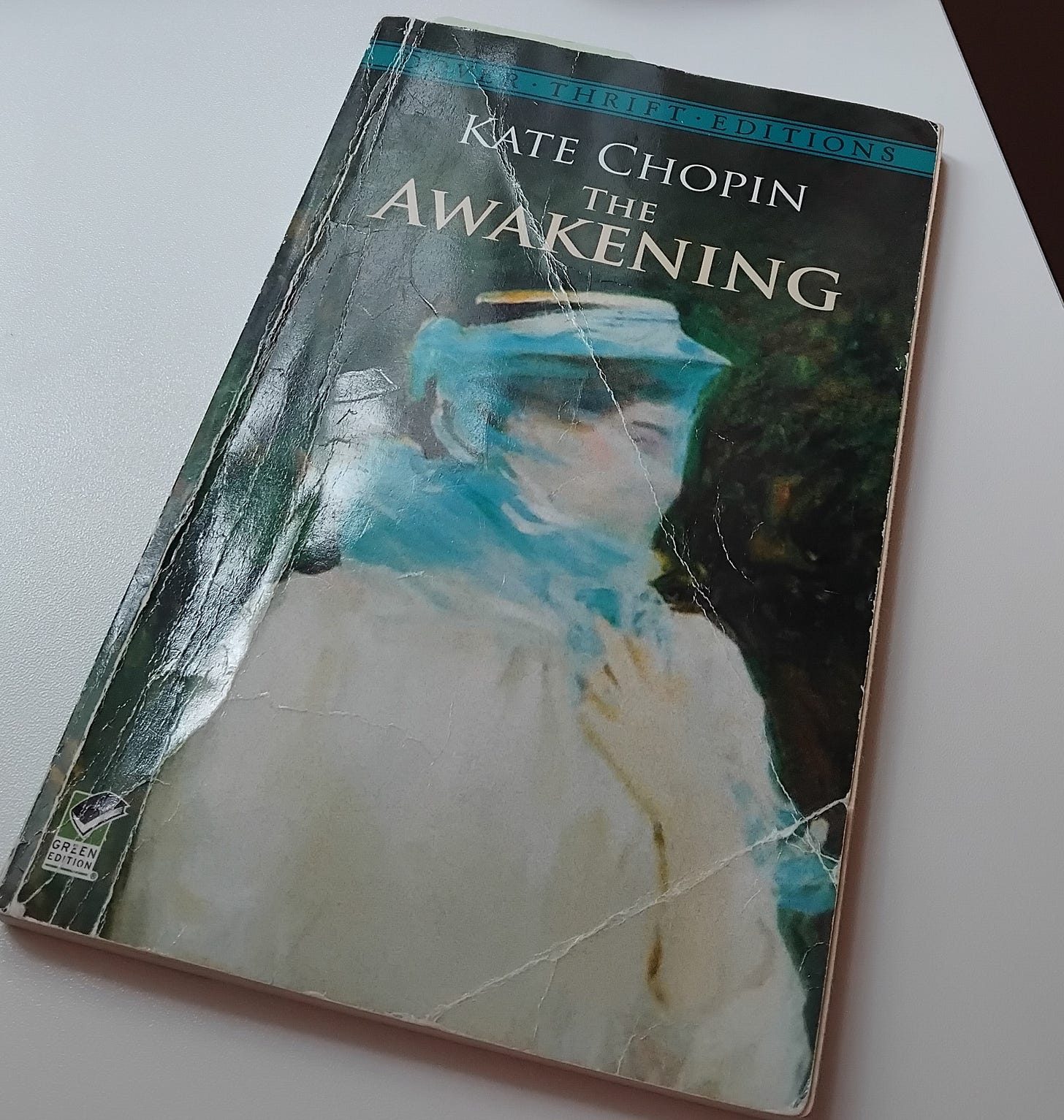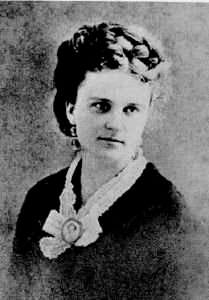Welcome to A Narrative of their Own, a weekly publication exploring the lives and literature of women.
If you enjoy reading essays on literature, as well as reviews of great books and recommended reading, please consider a free or paid subscription.
A couple of weeks ago, I wrote a post that resonated with a lot of readers, about how to be more creative amidst the chaos of real life, without the popularised trope of the artist who escapes into solitude.
This week, I want to explore one of my all-time favourite novels and the author who created it, because I think it speaks to both the trope of the female artist “abandoning” her responsibilities in order to create, as well as the creator of the novel, a mother who combined both a writing career with caring for a large family.
Edna Pontellier, the central character of Kate Chopin’s The Awakening, is a frustrated young wife, holidaying with her husband Léonce, and their two young sons at Grand Isle, Louisiana, in the Gulf of Mexico. At the opening of the novel, she is bored and feels a misfit amongst the other mothers, not being of Creole descent. Edna is from Kentucky and is Presbyterian, and her background and upbringing are presented as at odds with the other mothers within her milieu, as well as her husband and her friend, Adèle Ratignolle.
Written at the fin de siècle—a French term relating to or characteristic of the end of a century, especially the 19th century—Chopin deftly deals with the changing face of social and family life, and more specifically, with the development of the ‘New Woman’. The so-called New Woman challenged traditional gender roles within the family.
Published in 1899, Chopin suffered for her choice to portray such a character as Edna Pontellier within her short novel. The book was effectively unavailable for seventy years following its first publication, causing a moral outcry, with some critics claiming that Edna’s behaviour was ‘sickening and selfish’, for her transgression of moral codes.1
When we consider that the general belief was that Southern white women were immune to sexual desire, it is easy to see how Chopin challenged this in her creation of Edna’s sexual awakening. Edna was a Southern white, married woman, and what was more shocking to her critics: a mother. What really struck critics was Chopin’s exploration of childbirth and motherhood within the novel, with what some saw as her refusal to offer any authorial disapproval or moral guidance as would be expected in other novels of the time.
Interestingly, cultural studies of American history have shown that more women stayed single in the late 1890’s than at any other period, possibly as they were beginning to realise that this way they could retain their own identity more easily. It seems that Chopin reflected this in her heroine who, though married with two children at the beginning of the novel, leaves the marital home and sets up another house as a single woman, in order to pursue her artistic life. Perhaps not surprisingly, this led to the book’s reclamation by the women’s movement during the nineteen-seventies, another period of huge change for women’s freedom.
Chopin’s novella-length book broke the lengthier works of earlier novelists, and led from a position of emphasis on characterisation and the inner life of its central protagonist. In this way, Chopin’s writing moved away from traditional Realist fiction and anticipated the Modernist movement, preceding such writers as Virginia Woolf by around 25 years. The key to The Awakening being read as a modernist text is the fact that contains no superfluous characters, no major plot, is simply a reflection of the inner life of its central character, Edna Pontellier, and its use of symbolism which means that the reader can infer multiple meanings from the novel.
In order to emphasise the New Woman theme, Chopin’s use of opposing female characters serve to present alternative models of womanhood.
Madame Ratignolle, a friend of Edna’s, is presented as ‘the archetypal mother-woman’.2 She sews for her children, makes a nice home for her husband, and embodies many of the feminine attributes thought ‘suitable’ in nineteenth century society. Her marriage represents the ideals described in Coventry Patmore’s sequence of poems The Angel in the House; that idealised paragon of saintly womanhood immortalised in earlier literature. Adele Ratignolle is seen as a woman who adores her husband and dotes on her children, with Chopin’s narrator showing a direct contrast with Edna. To illustrate this further, Mr Pontellier, we are told, ‘felt rather than perceived’, that his wife ‘failed in her duty toward their children.’3
“Mr Pontellier had been a rather courteous husband so long as he met a certain tacit submissiveness in his wife. But her new and unexpected line of conduct completely bewildered him. It shocked him. Then her absolute disregard for her duties as a wife angered him. When Mr Pontellier became rude, Edna grew insolent. She had resolved never to take another step backward.”
Chopin also gives us a third iteration of womanhood in the form of Mademoiselle Reisz, a single woman and musician, who advises Edna that an artist must possess a courageous soul that dares and defies. Later, Edna herself goes on to reject her husband and children and live alone to work as an artist, selling her sketches, although eventually, she rejects this part of herself also.
Although Edna is driven to seek a sexual relationship outside of her marriage, primarily in the form of Robert Lebrun, a young man who is familiar with the families at Grand Isle, the novel is also about the blending of gender roles and the attempts of a woman to live her life as an independent artist.
In its portrayal of the breakdown of the Pontellier’s marriage due to Edna’s awakening sexual desires and her wish to live and work independently, the book reflects the gender instability of the time. As a point of reference for this, once Edna begins reaching beyond her gendered binaries to live a more independent life as an artist, we see her becoming increasingly androgynous.
“That is, he could not see that she was becoming herself and daily casting aside that fictitious self which we assume like a garment with which to appear before the world.”
Madame Ratignolle’s pregnancy spans the time of the novel and it has been suggested that Edna has a further, final awakening on witnessing her friend during childbirth, where we hear Edna’s ‘outspoken revolt against the ways of Nature.’ In witnessing her friend’s childbirth, we see that this holds no romance for Edna whatsoever. The family doctor in attendance advises her: ‘It seems to be a provision of Nature; a decoy to secure mothers for the race.’
Edna’s creator Kate Chopin had read and studied Charles Darwin’s Origin of Species, published in 1859, and which many critics have seen as influential on the thoughts she translated into the book. Although broadly agreeing with his work, she felt that he had left women’s sexual desires out of the discussion, assuming that these were simply a man’s purview. Perhaps in response to this, she created Edna as a passionate Southern white woman who awakens to her sexual desires, actively seeking out sexual partners outside of her marriage. Firstly, she begins a relationship with the young man Robert Lebrun, then, frustrated at his departure, she turns to another man, Alcee Arobin.
Eventually however, she experiences an epiphany: feeling let down by all men generally, she sees that: ‘it was not love which had held this cup of life to her lips…Above all, there was understanding. She felt as if a mist had been lifted from her eyes.’
This leads Edna to return to the scene where she first encountered Robert, deciding to swim out to sea. She finally appears calm and clear, realising that the day would come when Robert, and the thought of him, ‘would melt out of her existence.’ The recognition that love and sex can be separated plunges Edna into despondency, and leads to her final awakening.

Although Chopin creates a somewhat ambiguous ending, it is progressive in terms of its exploration and depiction of gender politics at the fin de siècle. Chopin, through not just The Awakening but also her other works, was commenting on the New Woman and the destabilising of the accepted gender politics, writing about women’s sexual desire when the prevailing ideology was that they had none at all.
However, it does appear to end in the unfortunate way many novels of this era ended: with the punishment of the female who has dared to stray from the shackles of sexual convention and the family home. I did wish that Chopin had dared to make her heroine a more successful female artist, free from the male gaze and the need for support, but perhaps she realised that would have been an even more difficult novel to publish. As it was, her novel was removed from sale and seen as a disgrace.
I also wondered however if Edna was a cipher for her creator Kate Chopin’s life and experience as a female artist and mother, tied as she was to her own children and stifled by the convention of the time.
Born in St Louis, Missouri in 1850, Kate Chopin was an American novelist and short-story writer who was perhaps best known for her interpretations of New Orleans culture. Achieving a certain amount of success during her lifetime, a revival of interest in her work came in the latter part of the twentieth century, as she was discovered by feminist scholars who recognised that her early work foreshadowed later feminist literary themes.
Born to a prominent St. Louis’ family, she married Oscar Chopin in 1870, a young cotton trader, moving to live with him first in his native New Orleans, Louisiana, then later to the family home in Cloutierville, La., near the Red River. After Oscar died in 1882, she returned with their six children to St. Louis, beginning to write eight years later as she was forced to support her children due to dwindling financial resources.
She began drawing on the Creole society she had observed during her marriage in the South, with her stories and sketches first appearing in magazines in 1889 and her first novel At Fault appearing in 1890. Later, she published her acclaimed, finely crafted short stories, during a particularly burgeoning local-colour movement focused on America’s distinctive regional cultures.* Her stories numbered over one hundred, some of which continue to be widely anthologised.
Publishing The Awakening in 1899, she was roundly condemned due to its sexual frankness and portrayal of an interracial marriage, as well as what many saw as the unforgivable attitude of her central character around motherhood. It subsequently went out of print before its reclamation by feminist critics in the latter part of the twentieth century, who recognised its modern sensibility and beautiful, symbolic style. It has rightly become a classic of feminist literature.
This came too late for Chopin, however, who had unfortunately always been sensitive to her critics. She gradually lost confidence in her writing, ceasing to write or publish any further work following the response to The Awakening.
As a female artist, it could be said that she suffered a similar fate to her protagonist, Edna. But I think it’s also worth considering her bravery in attempting to write a book based on a woman—a wife and a mother—who chooses to shun the acceptable path and walk away to claim her independence. Whilst Chopin herself was quite the opposite, financially supporting six children as a young widow, she must have felt stifled, at times, by such responsibility.
It seems that Chopin channelled some of her frustrations and longing into her most famous character Edna Pontellier, allowing her a chance to imagine another life—albeit a short lived one—as a free, female artist.
S Asbee, (2001),’ The Awakening: Identities’ and ‘The Awakening: Contexts’, in D Walder, (ed.), (2001), The Nineteenth-Century Novel, Identities, Milton Keynes, Routledge in association with the Open University.
S Asbee, & E Toth, (2006), The Nineteenth-Century Novel; Identities III, Audio CD, Track 2&3, Milton Keynes, The Open University.
Kate Chopin, [1899], 1993, The Awakening, New York, Dover Publications. (All further references taken from this edition). (All further quotations from this edition)
*It should be noted that parts of Chopin’s work such as The Awakening contain text pertaining to racial references and characteristics of the era which may be deemed offensive by modern standards.







"The book was effectively unavailable for seventy years following its first publication, causing a moral outcry"
Sad to hear the same old self-righteous protests against certain books and ideas growing louder in our land.
Such a great post and it made me want to read it. I had no clue how society punished her for her attempt of trying something new